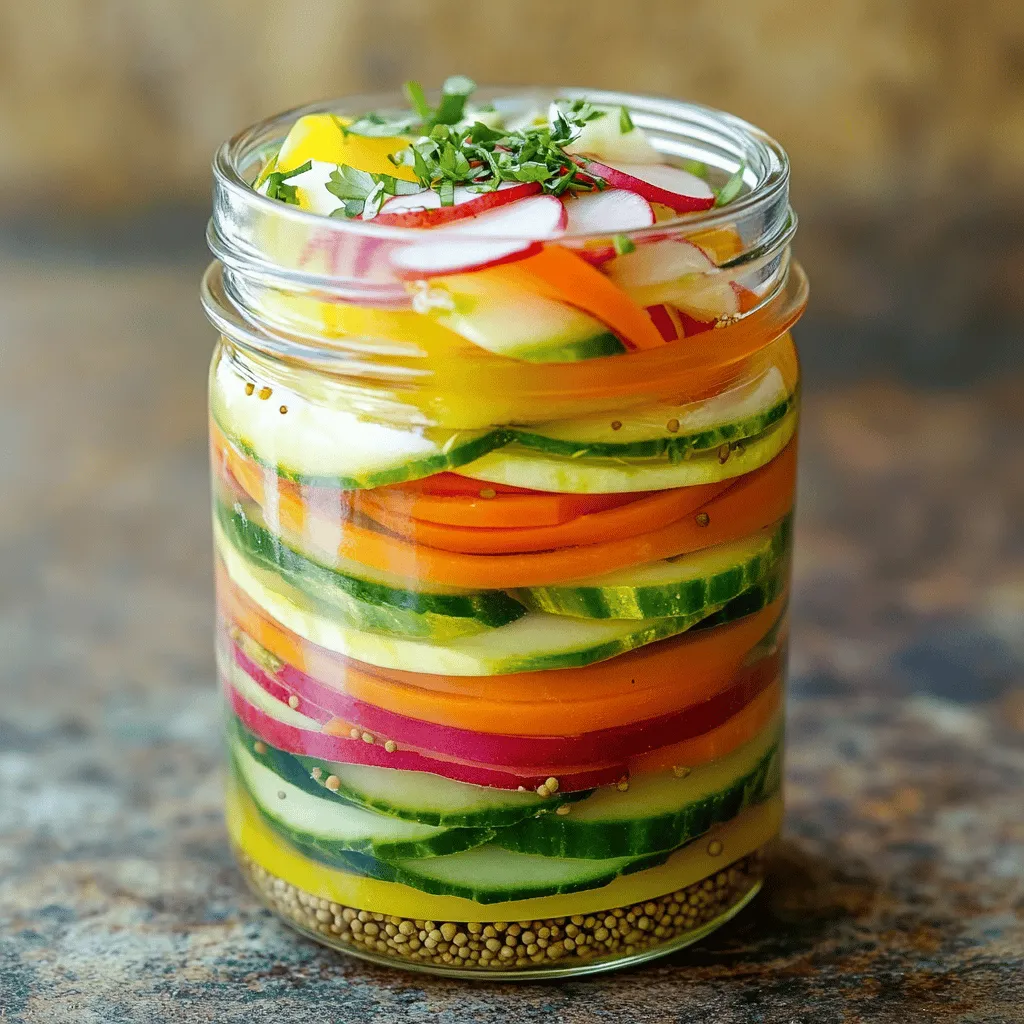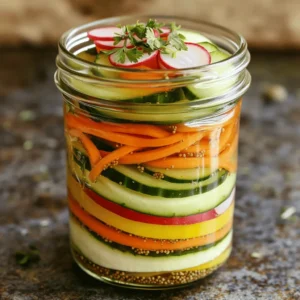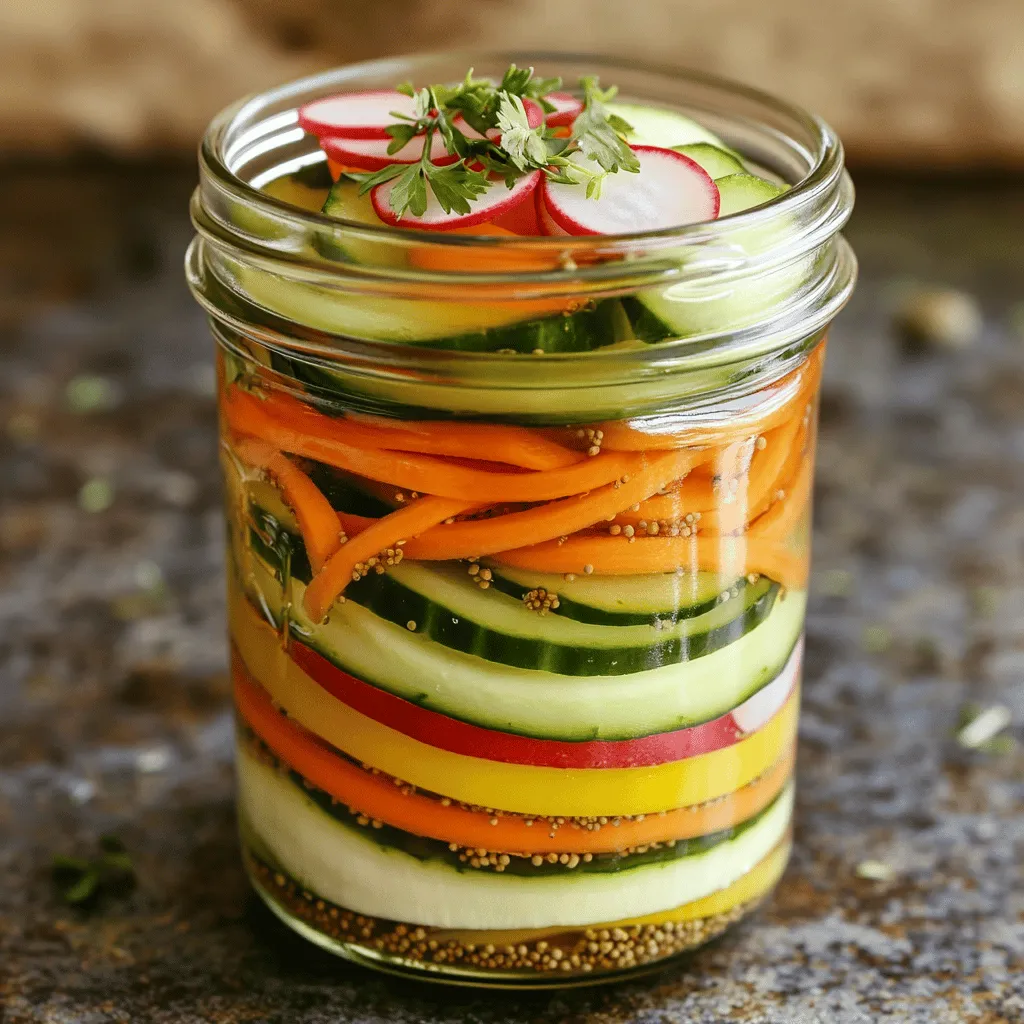Looking for a simple way to enhance your meals? Quick pickled vegetables are the answer! In this easy and flavorful recipe, I’ll show you how to create tangy, crunchy delights that bring life to any dish. You’ll learn about essential ingredients, step-by-step instructions, and handy tips for the best pickles. Let’s dive in and transform ordinary veggies into mouthwatering bites that you can enjoy anytime!
Ingredients
Essential Ingredients for Quick Pickling
– Sliced cucumbers
– Shredded carrots
– Thinly sliced red radishes
To make quick pickled vegetables, you start with fresh, crunchy veggies. I love using sliced cucumbers for their crispness. Shredded carrots add a sweet touch and bright color. Thinly sliced red radishes bring a peppery bite that wakes up the taste buds.
Flavorful Add-ins
– Mustard seeds
– Coriander seeds
– Red pepper flakes
Adding spices enhances the flavor of your pickles. Mustard seeds give a nice crunch and a tangy taste. Coriander seeds add a warm, earthy note. If you like heat, sprinkle in some red pepper flakes. Adjust the amount to match your spice level.
Pickling Liquid Components
– Apple cider vinegar
– Sugar and salt
– Garlic
The pickling liquid is key to great flavor. I use apple cider vinegar for its fruity acidity. It balances well with sugar and salt, which help to bring out the flavors. Adding smashed garlic infuses a wonderful aroma and depth. This combo creates a bright and tangy liquid that transforms your veggies.
For the full recipe, check out the Zesty Quick Pickled Veggies 🥒 section.
Step-by-Step Instructions
Preparing the Pickling Liquid
To start, I combine water and apple cider vinegar in a medium saucepan. This mix forms the base of our pickling liquid. I add one tablespoon of sugar and one tablespoon of salt. I heat the mixture over medium heat. I stir it occasionally until the sugar and salt dissolve completely. This step is key for balance in flavor.
Infusing Flavors
Next, I turn up the flavor. I add one teaspoon of mustard seeds, one teaspoon of coriander seeds, two smashed garlic cloves, and one teaspoon of red pepper flakes. This blend brings warmth and depth to the pickles. I bring the mixture to a gentle simmer for about one to two minutes. This helps the spices release their aromas and flavors into the liquid.
Packing the Vegetables
Now, I prepare my veggies. I slice cucumbers, shred carrots, and thinly slice red radishes and bell peppers. I place all these colorful veggies into a large, heatproof jar or container. Then, I carefully pour the warm pickling liquid over the veggies. I make sure they are fully submerged. If any float, I gently press them down with a spoon. Once done, I let the jar cool to room temperature. After that, I seal it with a lid. For the best taste, I recommend refrigerating the pickles for at least two hours, but overnight is even better. You can find the full recipe here.
Tips & Tricks
Best Practices for Quick Pickling
To make sure your quick pickles turn out great, keep these tips in mind:
– Ensuring vegetables are submerged: This is key for even flavor. When you pour the pickling liquid over the veggies, they should be completely covered. If some float, use a spoon to push them down gently. This helps every piece soak up that tangy goodness.
– Cooling time for optimal flavor: After you seal the jar, let it cool at room temperature. This step is crucial. It allows the flavors to meld together nicely. For the best taste, chill the pickles in the fridge for at least two hours or overnight. The longer they sit, the better they taste!
Serving Suggestions
When serving your quick pickled vegetables, think about how to make them shine:
– Presentation ideas for serving: Use a clear glass jar to show off the colors of the pickles. You can sprinkle some fresh herbs on top for a pop of green. This not only looks nice but adds a fresh taste as well.
– Pairing with different dishes: Quick pickled veggies are versatile! Serve them with grilled meats for a zesty side. They also brighten up salads, sandwiches, and tacos. You can even add them to charcuterie boards for a fun twist.
Enhancing the Flavor
Want to take your pickles to the next level? Here are some tasty ideas:
– Adding herbs or citrus zest: Fresh herbs like dill or cilantro can bring a new layer of flavor. You can also add a bit of lemon or lime zest for a citrusy kick. This adds freshness and enhances the overall taste.
– Adjusting spice levels to your preference: If you like heat, feel free to increase the red pepper flakes. You can also experiment with other spices like black pepper or chili powder. Adjust to your liking for the perfect balance!

Variations
Alternative Vegetables to Use
You can change up the veggies in your quick pickles. Try using radishes for a spicy kick. Zucchini also works great for a mild taste. Green beans add a nice crunch. Asparagus brings a fresh, bright flavor to the mix. These options can change the whole vibe of your pickles. Feel free to use what you have on hand!
Different Pickling Flavors
Switching vinegars can alter the taste. Use rice vinegar instead of apple cider for a sweeter flavor. It also gives your pickles a nice tang. You can also play with spices. Adding dill seeds, black peppercorns, or even ginger can bring new flavors. Get creative and see what you like best!
Quick Pickling for Special Diets
If you need low-sodium options, simply cut back on the salt. You can also leave out the sugar for a sugar-free version. This way, your pickles will still taste great. For vegan diets, all your veggies are plant-based! These pickles fit right into any meal plan. Enjoy them in salads or as a snack.
Storage Info
Proper Storage Techniques
To keep your quick pickled vegetables fresh, choose the right container. Glass jars work best. They let you see the colors and are easy to clean. Make sure your jars have tight lids. This keeps air out and flavors in. After you make your pickles, put them in the fridge. Cold temperatures help keep them crisp and tasty.
Shelf Life of Quick Pickled Vegetables
Quick pickled vegetables last about 1 to 2 weeks in the refrigerator. After that, they may lose their crunch. Look for signs of spoilage. If the pickles become soft or the liquid turns cloudy, it’s time to throw them out. Always trust your senses. If something smells off, it’s better to be safe.
Freezing Quick Pickles
You can freeze quick pickled vegetables, but it’s not the best idea. Freezing changes their texture. If you want to freeze them, use freezer-safe bags. Remove as much air as you can to prevent freezer burn. When you want to use them, just thaw in the fridge. They might not be as crunchy, but they will still taste good in cooked dishes. For a full recipe, check out the Zesty Quick Pickled Veggies.
FAQs
How long do quick pickled vegetables last?
Quick pickled vegetables can last about 2 to 4 weeks in the fridge. Keep them in a clean, airtight jar. Make sure to always use clean utensils when serving. This helps avoid bad bacteria. If you see any signs of spoilage, like mold or off smells, it’s best to throw them away.
Can you use different types of vinegar?
Yes, you can use many types of vinegar for pickling. Apple cider vinegar gives a sweet and tangy flavor. White vinegar is sharp and strong. Rice vinegar is mild and slightly sweet. Each type changes the taste of your pickles. Experiment to find your favorite!
What dishes can quick pickled vegetables complement?
Quick pickled vegetables add flavor and crunch to many meals. Use them in tacos, sandwiches, or salads. They also pair well with grilled meats or fish. Serve them as a side dish or snack. Their bright colors make any plate more appealing. You can find more ideas in the Full Recipe.
Is there a way to make pickled vegetables more spicy?
Yes, you can add more heat to your pickles. Increase the amount of red pepper flakes in your recipe. You can also add sliced fresh chili peppers. If you love garlic, try adding more smashed cloves. Adjust the spices to your taste for the perfect kick.
Quick pickling is a simple way to make tasty vegetables at home. You learned about key ingredients, how to prepare the pickling liquid, and tips for picking various veggies. The right jar and storage can make them last longer. You can enjoy your pickles as a snack or alongside meals. Experimenting with flavors adds fun. Now, you have the tools to create your own quick pickles. Enjoy your cooking and all the crunchy goodness that follows!

